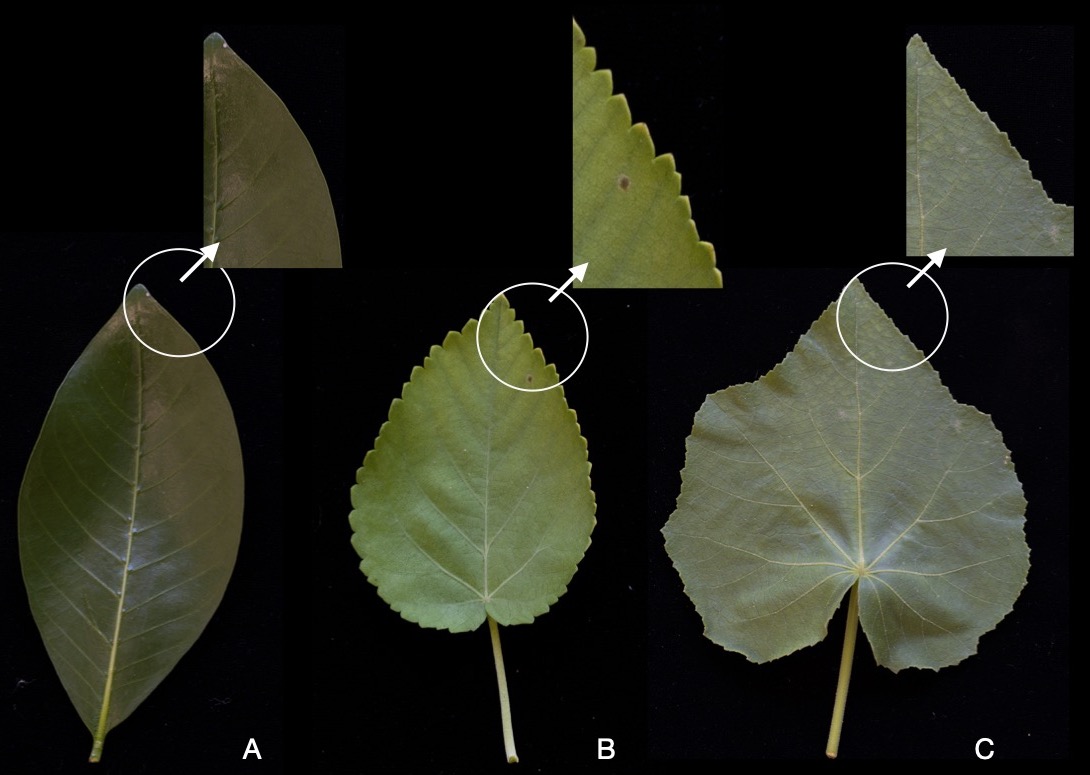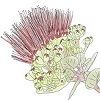4.1: Leaf structure
- Page ID
- 59228
\( \newcommand{\vecs}[1]{\overset { \scriptstyle \rightharpoonup} {\mathbf{#1}} } \)
\( \newcommand{\vecd}[1]{\overset{-\!-\!\rightharpoonup}{\vphantom{a}\smash {#1}}} \)
\( \newcommand{\id}{\mathrm{id}}\) \( \newcommand{\Span}{\mathrm{span}}\)
( \newcommand{\kernel}{\mathrm{null}\,}\) \( \newcommand{\range}{\mathrm{range}\,}\)
\( \newcommand{\RealPart}{\mathrm{Re}}\) \( \newcommand{\ImaginaryPart}{\mathrm{Im}}\)
\( \newcommand{\Argument}{\mathrm{Arg}}\) \( \newcommand{\norm}[1]{\| #1 \|}\)
\( \newcommand{\inner}[2]{\langle #1, #2 \rangle}\)
\( \newcommand{\Span}{\mathrm{span}}\)
\( \newcommand{\id}{\mathrm{id}}\)
\( \newcommand{\Span}{\mathrm{span}}\)
\( \newcommand{\kernel}{\mathrm{null}\,}\)
\( \newcommand{\range}{\mathrm{range}\,}\)
\( \newcommand{\RealPart}{\mathrm{Re}}\)
\( \newcommand{\ImaginaryPart}{\mathrm{Im}}\)
\( \newcommand{\Argument}{\mathrm{Arg}}\)
\( \newcommand{\norm}[1]{\| #1 \|}\)
\( \newcommand{\inner}[2]{\langle #1, #2 \rangle}\)
\( \newcommand{\Span}{\mathrm{span}}\) \( \newcommand{\AA}{\unicode[.8,0]{x212B}}\)
\( \newcommand{\vectorA}[1]{\vec{#1}} % arrow\)
\( \newcommand{\vectorAt}[1]{\vec{\text{#1}}} % arrow\)
\( \newcommand{\vectorB}[1]{\overset { \scriptstyle \rightharpoonup} {\mathbf{#1}} } \)
\( \newcommand{\vectorC}[1]{\textbf{#1}} \)
\( \newcommand{\vectorD}[1]{\overrightarrow{#1}} \)
\( \newcommand{\vectorDt}[1]{\overrightarrow{\text{#1}}} \)
\( \newcommand{\vectE}[1]{\overset{-\!-\!\rightharpoonup}{\vphantom{a}\smash{\mathbf {#1}}}} \)
\( \newcommand{\vecs}[1]{\overset { \scriptstyle \rightharpoonup} {\mathbf{#1}} } \)
\( \newcommand{\vecd}[1]{\overset{-\!-\!\rightharpoonup}{\vphantom{a}\smash {#1}}} \)
Leaves are commonly used in our day to day lives, from the fresh salad we may eat for dinner to perfumes, leaves are used to make a diversity of products. Some leaves even have great economical importance. The most important product derived from leaves is tea (Camellia sinensis), which is the most widely consumed beverage. The growing, harvesting, and processing of tea is very intricate and the end product is highly valued around the globe, an industry worth billions of dollars per year. Other products derived from leaves include essential oils extracted used in cleaning products, medications and bug repellent. The oil from citronella/lemongrass leaves (Cymbopogon citronella) are extracted and used to enhance flavor in foods, in cosmetics, perfumery, and in vitamins, among other products. The leaves of lemongrass, mint (Mentha spicata), and māmaki (Pipturus albidus) are used to make herbal teas (Figure \(\PageIndex{1}\)). Many people around the world use the leaves of hundreds of plant species for medicinal purposes. In Hawaiʻi, māmaki leaves are used for traditional medicinal uses.
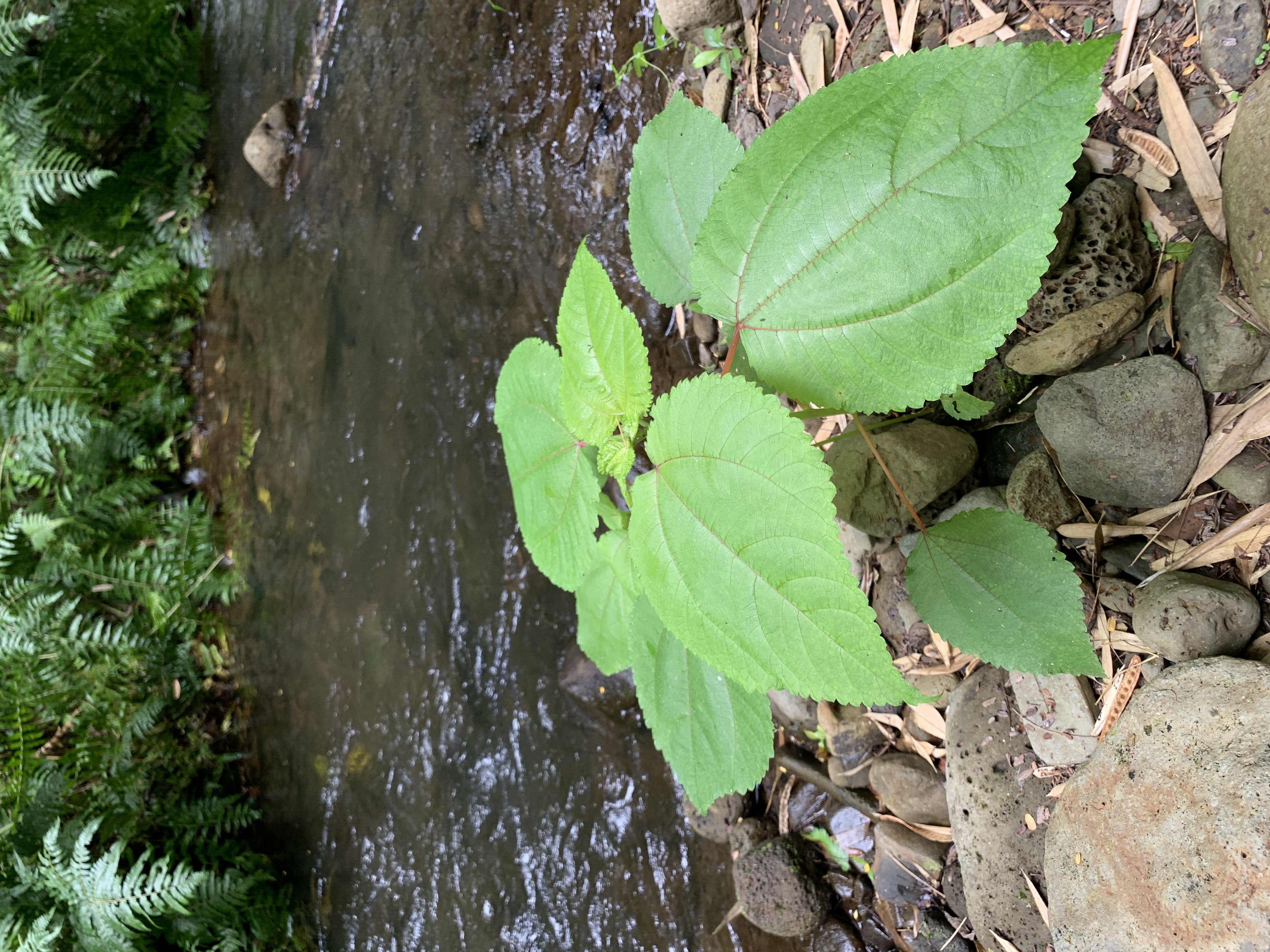
Leaves are variable in shape, size, and color. Some palm tree leaves can measure 4–6 m (13–20 ft) in length, while duckweed leaves are tiny as 1 millimeter (0.04 inch). In regards to shape, some leaves are like needles, as in pine trees, or they can be very broad like in kalo leaves. Plants are able to synthesize their own food using sunlight and carbon dioxide. In turn, humans and other animals rely on plants for food and oxygen that they also produce.
Parts of the leaf and leaf attachment
The flat part of the leaf is called the lamina or blade. Leaves normally attach to the stems by a short stalk called the petiole. The leaf lamina has a midrib where the vascular tissues are located. From the midrib, smaller veins, also containing vascular tissue, branch out. The edge of the blade is called the margin (Figure \(\PageIndex{2}\)). Leaf margins differ in plants and are used as an identification tool for species. They can also vary in different environments, for example, most plants in tropical rainforests have entire (smooth) margins, while plants in temperate regions usually have margins with teeth.
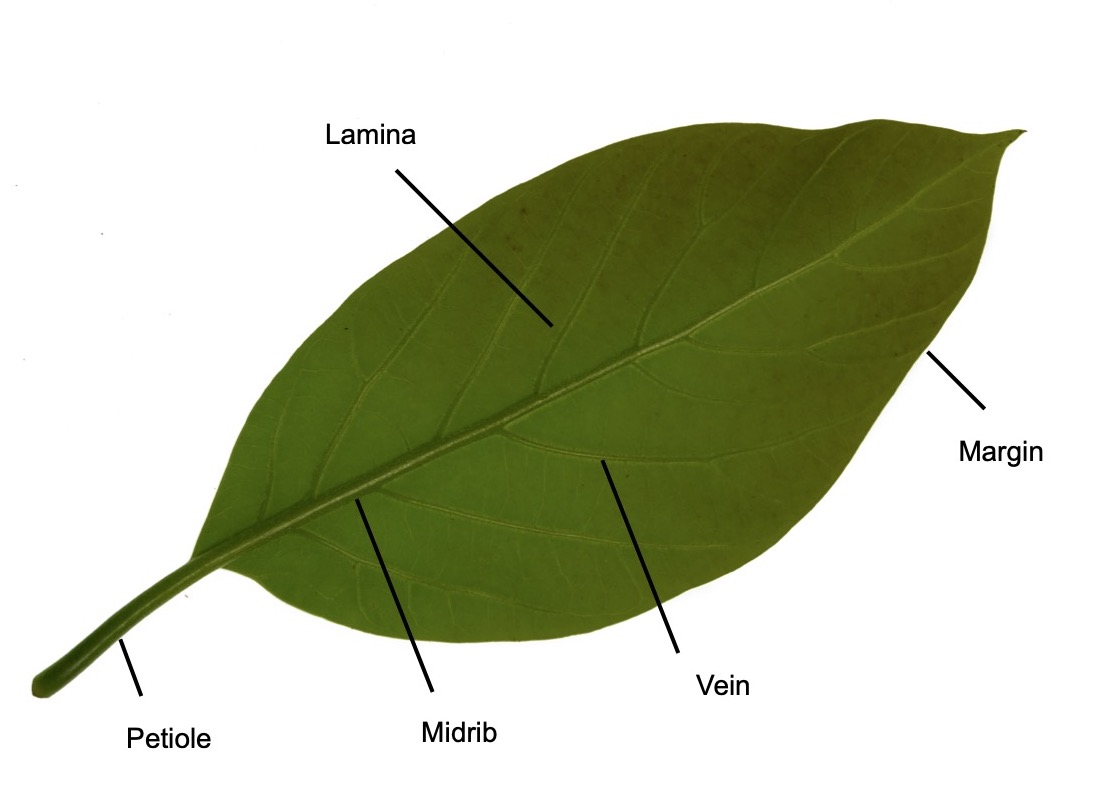
Leaves attach to the stems at the nodes, and the space between nodes is called internodes. If we take a closer look at the nodes, we will find that in the angle between the leaf stalk (petiole) and the stem, there is a little rounded bump called a bud, which is composed of dormant meristematic tissue that can develop into flowers, branches, or leaves (Figure \(\PageIndex{3}\)).
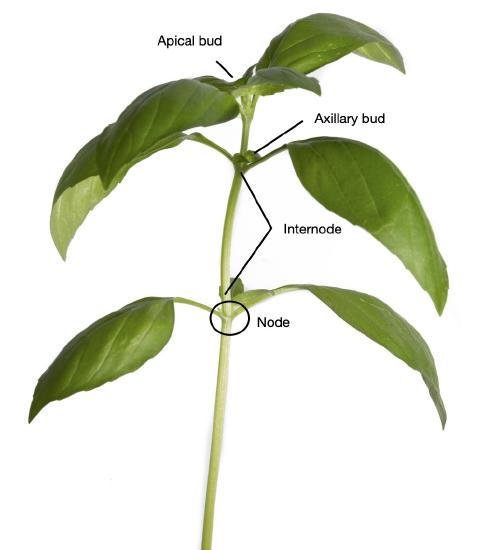
The pattern of leaf attachment to the stem (phyllotaxy) varies in plants and it is commonly used for identification purposes. For example, in some plants two leaves attach on opposite sides of a node (opposite), in others there is only one leaf per node (alternate), in others 3 or more leaves attach around the stem at the same node, forming a whorl of leaves (whorled), or even forming a spiral around the stem by slightly rotating the attachment position in each subsequent node (spiral; Figure \(\PageIndex{4}\)).
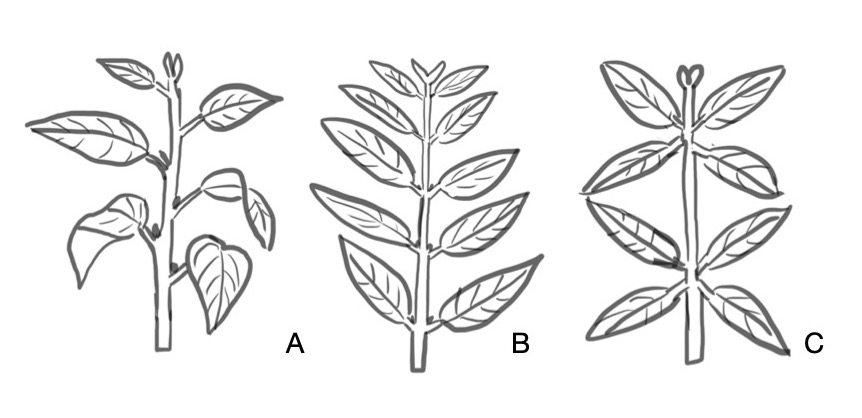
Simple vs. Compound leaves
Leaves may be simple or compound, meaning they can have one or several lamina (blades). In a simple leaf, the lamina is undivided or it has lobes, but the lobes do not reach the midrib (Figure \(\PageIndex{5}\)). In a compound leaf, the leaf lamina is completely divided, forming smaller independent “leaves” called leaflets (Figure \(\PageIndex{5}\)).
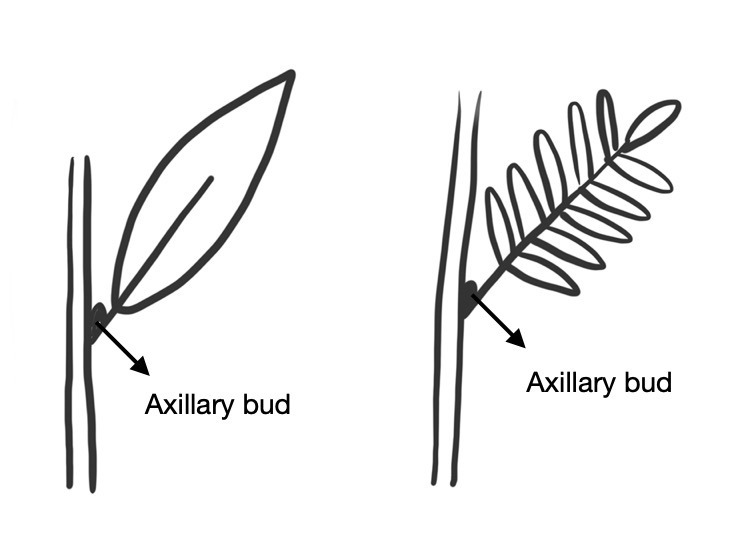
Each leaflet has its own petiole but is attached to the midrib, which in compound leaves is called rachis. There are different types of compound leaves, depending on how the leaflets are arranged. In pinnately compound leaves the leaflets are arranged on both sides along the raquis (e.g. starfruit, Figure 5B). Double pinnately compound leaves or bipinnately compound leaves are similar to pinnately compound leaves, but each leaflet is further divided into even smaller leaflets (e.g. albizia; Figure \(\PageIndex{6}\)). In palmately compound leaves leaflets attach to a single point and radiate from there, resembling the palm of a hand (Figure \(\PageIndex{6}\)). An example of a plant with palmate compound leaves is Schefflera sp. (umbrella plant).
Leaf venation
Veins in leaves are arranged in different patterns and they are another characteristic that is very helpful in plant identification (Figure \(\PageIndex{7}\)). Pinnate leaf venation is the first to come to mind when we think about a typical leaf. In pinnate venation, there is a midvein or midrib and secondary, smaller, veins branching to either side of the midvein. An example of a plant with pinnate venation on its leaves is avocado (Figure \(\PageIndex{7}\)). In parallel venation, secondary veins are parallel to the midrib and each other. Parallel venation is characteristic of monocots, like grasses and kī/ tī (Figure \(\PageIndex{7}\)), although there are some exceptions (e.g. kalo). In palmate leaf venation, there are several main veins of similar thickness that radiate from a single point at the base of the leaf (e.g. kukui leaf; Figure \(\PageIndex{7}\)). In eudicots, the branching pattern seen as the veins further divide into smaller veins resembles a net, so it is called reticulate (netted) venation.
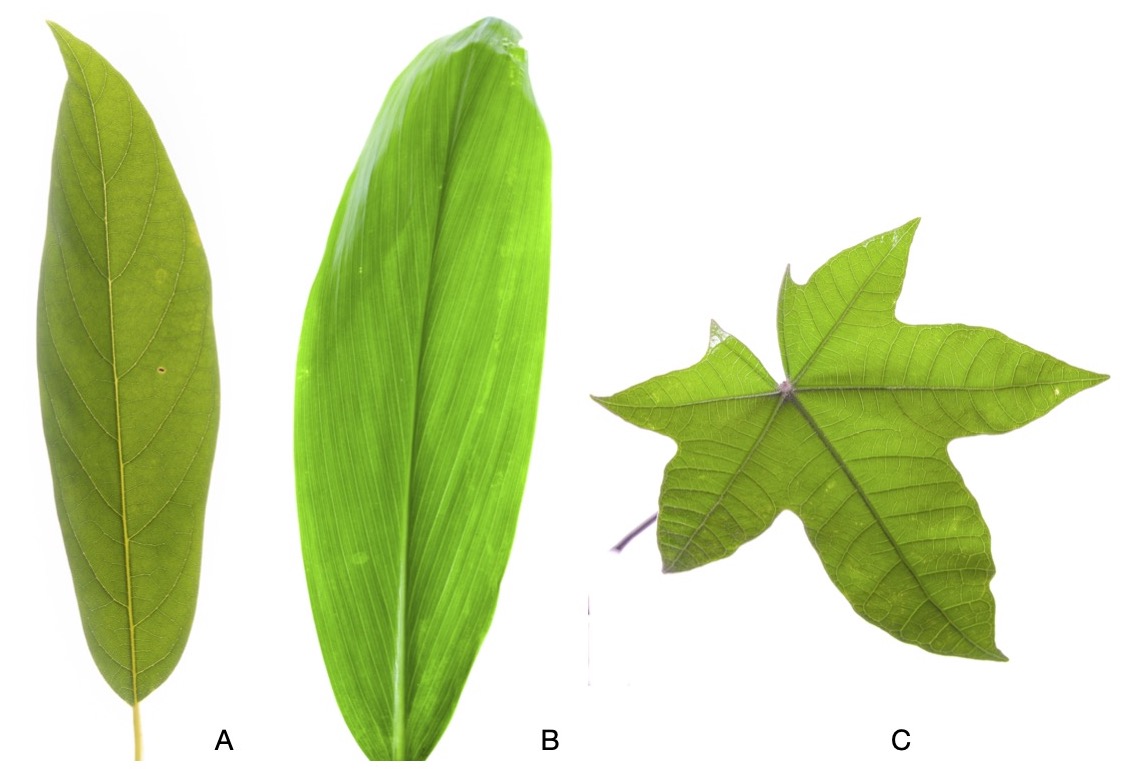
Leaf Margins
Leaves have a diversity of margin types or edges, which is a very useful characteristic in plant identification. Examples of the most common margin types are entire, dentate, and serrate (Figure \(\PageIndex{8}\)). If you are trying to identify a plant to the species level, you will likely encounter keys and descriptions that include leaf margins and there are many to choose from.
